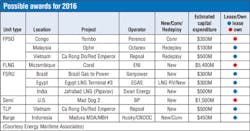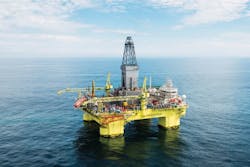Floating production market shows signs of recovery
While only a few floating production systems have been ordered this year, Energy Maritime Associates (EMA) says it expects the market to improve next year. In its “4Q 2016 Floating Production Systems Report,” EMA reviewed the market for floating production systems, including FPSOs, FLNGs, FSRUs, TLPs, spars, semis, FSOs, and MOPUs.
In 3Q 2016, two more FSRU contracts were awarded, bringing the total this year to four units - all FSRUs. Three of these awards were for speculative newbuild units, while the other was deployment of the LNG regas vesselExcelerate for FSRU service in Abu Dhabi. Chevron awarded a $230-million contract to MISC to convert an FSO to replace the Benchamas Explorer, which has been operating in Thailand since 1999. In addition, three units were delivered: one semi (Petrofac’s FPF-1), one LNG FSO (Bumi Armada’s LNG Mediterrana), and one MOPU (Uzma’s Marsya).
The analyst has identified certain signs of an improving FPS market.
According to the report, EMA has identified 10 possible awards within 2016. However, most will be deferred into 2017 as oil companies continue to push back spending. The most likely upcoming awards have a combined capex of $6.35 billion: Coral FLNG (Mozambique), Ophir FPSO (Malaysia), Yombo FPSO (Congo), and Ca Rong Do FPSO and TLP (Vietnam).
The analyst says after a two-year pause, Petrobras plans to order seven FPSOs by 2018: for the Libra Pilot and Sepia (tenders under way), Buzios V, Marlim Revitalization I and II, Libra 2, and Parque das Baleias developments.
The report also identified 46 idle FPS units: 24 FPSOs, 10 production semis, six FSOs, five MOPUs, and one FLNG. This is up from 26 at the beginning of the year. According to EMA, while some will be put back in service, the majority will likely be recycled, like the FPSOFalcon. This FPSO was first of three “generic” West African FPSO ordered by Exxon, which were designed for a range of field properties, weather conditions, and water depths. Despite these features, it was never redeployed.
David Boggs, managing director of EMA, said: “Unless there is a sudden surge of awards in the next two months, 2016 will be the worst year ever for the floating production market. We expect improvement next year as companies are reassured by more stable oil prices and take advantage of lower costs.
“The record low drilling rates in particular create a window of opportunity for deepwater and marginal fields. Reuse of available assets can also enable cost-efficient production. However, this situation will not last forever. Companies that take FID sooner will benefit from availability and reduced costs throughout the supply chain, while those that delay too long will find costs escalating beyond expectations.”
DNV GL issues guidelines on drilling rig air gaps
About 100 semisubmersible drilling rigs approved by DNV GL will undergo further reviews following the accident involving theCOSLInnovator offshore Norway late last year. It appears that a limited number of rigs will be subjected to modifications or operational limitations.
TheCOSLInnovator was drilling for Statoil on the Troll field when it was struck by a large, steep wave, which shattered several windows on the rig’s two lower decks. One person was killed.
Ernst Meyer, DNV GL director for Offshore Classification, said: “Since the incident, we have made great efforts to identify what happened, understand how this could happen and, most importantly, implement actions to prevent similar incidents from occurring again.
“We have been working with rig owners, designers, operators, and authorities towards a common goal; to ensure the safety of all those working on board the rigs.”
Petroleum Safety Authority Norway’s investigation concluded earlier this year that its findings must be used to prevent similar incidents occurring in the future. In response, DNV GL published a new technical guideline (OTG-13 - Prediction of air gap for column-stabilised units), said to deliver a consistent and updated approach for calculating the air gap - the clearance between the highest wave crest and the bottom of the deck box in all relevant sea conditions.
Recently, DNV GL asked all owners of semis that it had classed to provide updated documentation of each rig’s air gap. Those that can, based on the new guideline, provide a positive air gap will be able to operate as before without reinforcements or operational limitations. This should be the case for most semis operating on the Norwegian shelf.
“A limited number of rigs may not have a positive air gap,” Meyer said, “but most of these will be able to avoid changes. The prerequisite is that they are able to document a positive air gap for a specific location, or that they simply do not have windows that may be exposed to waves.”
As for those rigs where the owners cannot demonstrate a positive air gap in all sea conditions - including the 100-year wave - Meyer added: “Initially (for the next winter), these rigs will be required to remove windows in exposed zones. If the strength calculations show that further structural modifications are necessary, such modifications will be required as part of the permanent solution.
“The most important thing is that the windows are removed before the coming winter. This action eliminates the largest risk elements if a similar incident occurs.”
Rigs certified for worldwide operation must be documented according to North Atlantic wave data. Most rigs operate in milder areas, such as the North Sea, and can postpone modifications that might be needed for the Norwegian Sea or Barents Sea.



